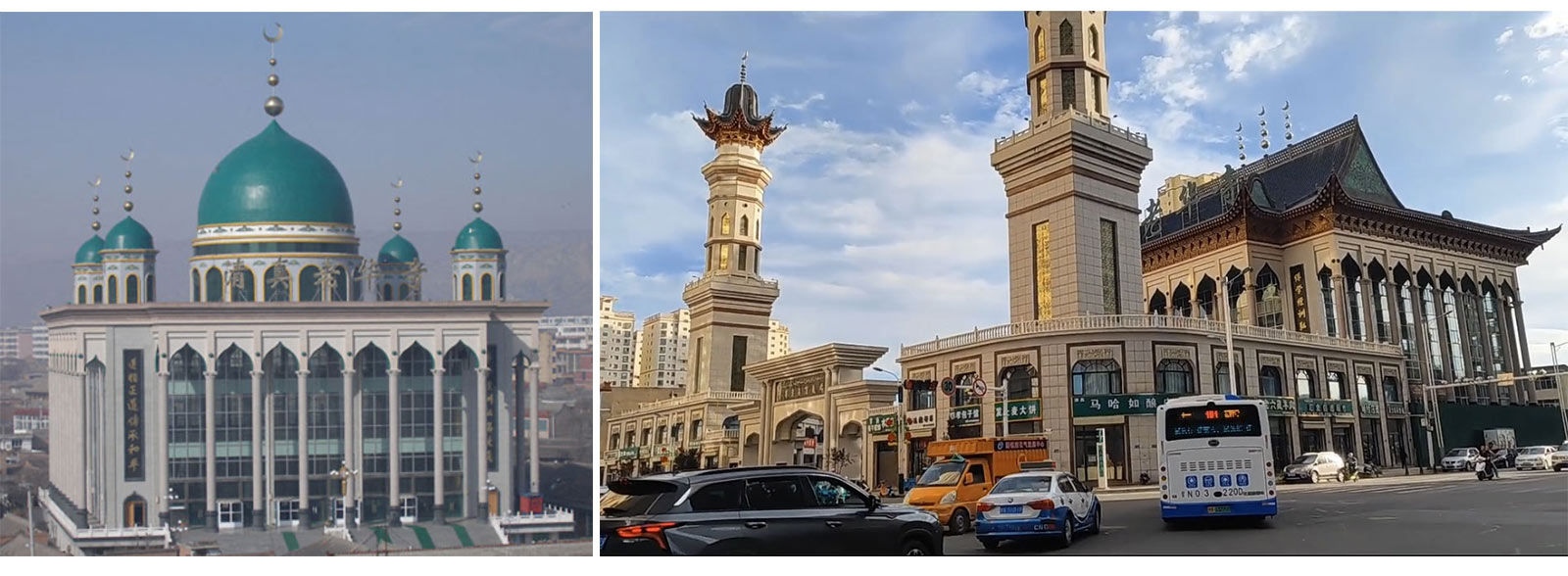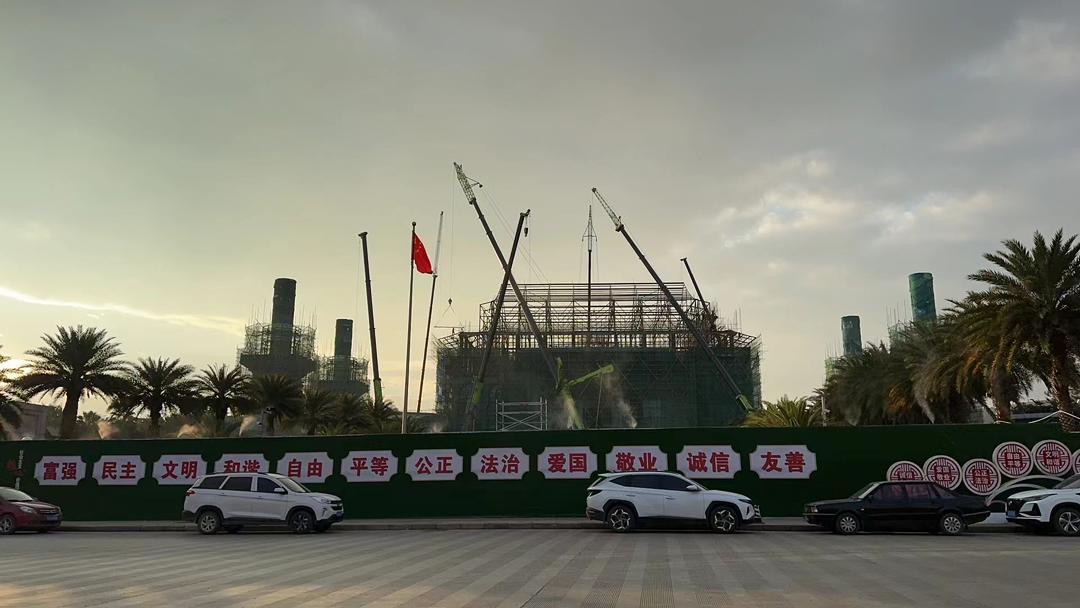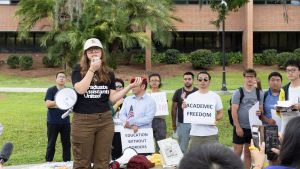
Sinicising Islam in China: The Story of a Mosque
Laohuasi (清真老华寺) is a Sufi mosque in Linxia, a city in China’s Gansu Province. Standing on a raised platform the length and breadth of a football field, it has four floors and two large prayer halls that can accommodate more than 6,000 worshippers. A colour image of it in a book titled Chinese Islamic Architectural Art also shows five green domes—four small and one large—arranged on its rooftop in a quincunx pattern (Bai 2016: 385). Five more mosques with similar architectural features can be seen dotting the city skyline in the background.
Snapshots of Laohuasi taken by Han Chinese tourists in the summer of 2023, however, reveal that those domes are gone. Instead, a large hip-and-gable roof with corners projecting beyond the walls now sits atop the mosque’s prayer halls. Two minarets standing by the gate to the courtyard have also lost height. These architectural changes are due to the nationwide campaign to ‘Sinicise Islam’ (伊斯兰教中国化) in China, which has been undertaken by the Chinese authorities in the belief that the religion in the country is undergoing so-called Arabisation (阿化) and Saudi-isation (沙化).
The details of the campaign were discussed in 2017 at a meeting of the Chinese Islamic Association, the state-led representative organ for Islamic affairs in the country. In 2018, the association circulated a five-year plan—later deleted from its official website––which stated that ‘some places blindly imitate foreign styles of mosque architecture’ and proceeded to advise that the ‘renovation, construction, and expansion of mosques’ should be ‘suited to China’s characteristics, highlighting Chinese elements’ (China Law Translate 2019). Hundreds of mosques across the country have since had their domes and minarets amputated. In addition, recent reports by human rights groups suggest many mosques have been destroyed as the authorities aim to decrease their number in the name of ‘consolidation’ (HRW 2023).

The campaign was launched in the wake of a meeting on religious work chaired by Chinese President Xi Jinping in April 2016. In his speech, Xi instructed religious groups to ‘adhere to the leadership’ of the Chinese Communist Party (CCP) and merge their doctrines with Chinese culture (Xinhua 2016). The problematisation of mosques’ architectural styles should thus be seen as part of a larger trend to assimilate, or render invisible, religious and ethnic differences that do not conform to Xi’s ethnonationalist vision of Chinese civilisation. In Xinjiang, this vision has been used to justify the mass incarceration of Turkic Muslim minorities and the demolition of their religious sites (Byler 2021; Thum 2020). In Tibet, children are separated from their families and sent to boarding schools to learn what it means to be Chinese, while youths in Inner Mongolia are progressively restricted from learning their language (OHCHR 2023; Atwood 2020; Kashgar 2023). Meanwhile, a recent campaign to strip churches of their crosses (Johnson 2016) has reportedly been followed by officials demanding people replace images of Jesus in their homes with photos of CCP leaders (Gan 2017).
This is not the first time that mosques have fallen victim to state power in China. The photo of Laohuasi in the book mentioned above, for example, is accompanied by the following description:
This mosque was constructed circa 1380. It was expanded in 1775 … It was burned down by the Republican army in 1928. It was rebuilt in 1930. It was burned down again during the Cultural Revolution. It was rebuilt in 1981 and constantly expanded since then. In 2004, when the old prayer hall was no longer able to accommodate the worshippers, the mosque was reconstructed anew with donations from Muslims. Its design blends Arabic style with Chinese traditional style. (Bai 2016: 385)
The painful history of this mosque—which continues with the recent ‘renovation’ in the name of Sinicisation—vividly, if tragically, illustrates the precarious condition of organised religion in a totalising state.
As I describe in my book manuscript project, the aspects of Chinese Islam targeted by the authorities today are the very elements that local governments authorised in their respective localities until very recently. Much of the previous permissiveness was because the CCP wanted to distance itself from the destructive tumult of the Cultural Revolution and explore the extent to which it could administer religious and ethnic differences in ways conducive to the market economy. The town of Shadian in Yunnan Province where I did my fieldwork, for example, is infamous for a state-sponsored massacre of Chinese Muslims in 1975. Religious activities in town resumed when the incident was redressed in 1979: not only did the government rebuild the Ming-era Grand Mosque of Shadian that it had bombed just four years earlier, but it also paid for the construction of four more mosques in the town. The community was given a set of preferential policies to develop the economy and, at the turn of the century, Shadian Muslims who grew rich through tin mining proposed funding the renovation of the government-built Grand Mosque according to a new design that emulated the iconic look of the Prophet’s Mosque in Medina. Opened to the public in 2010, the building rose from the shadows of the Cultural Revolution with three prayer halls that could accommodate 10,000 people and a large green dome flanked by four minarets as high as 70 metres.

The construction of mosques in Arabic style, then, was truly a sign of the times. In 1982, the CCP issued Document No. 19 (translated in full in MacInnis 1989: 8–26), in which it renewed its interaction with religion as an administrative category. Seeking to benefit from this policy, members of recognised religions across China invested in the revival of their rituals, practices, and traditions. Constructing places of worship—quite often on the sites once occupied by religious buildings destroyed during the Cultural Revolution—or negotiating with the authorities for an expansion of existing ones was central to this process. After all, these were not only spaces of the sacred but also sacred spaces through which the state could exercise its control. In a newly published ethnography of one Buddhist temple in the coastal city of Xiamen, for example, Ashiwa and Wank (2023) show how, during the Reform Era, the building served as a source of political legitimacy that extended both ways: officials gained political capital by approving its rebuilding and expansion, and the faithful gained a religious space relatively free from political interference.
The national drive to amputate mosque minarets and domes, therefore, should be understood within the politics of religious freedom that led to the construction of these structures in the first place. Local communities in China have little power to stop the authorities from going after their mosques. The political situation in the country now is such that defending their architecture in terms of policies sidelined by Xi’s ethnonationalist vision could push the faithful and the clergy to the wrong side of the law. However, this does not mean that local religious communities are entirely powerless. Even though this usually goes unnoticed by outside observers, many manage to enter negotiations with the authorities to secure a measure of advantage for themselves if they feel they can read the political script of current religious politics ‘correctly’.
Photos of the ‘renovated’ Dongguan Mosque complex in Xining City, Qinghai Province, for example, show that the building has gained two more floors for religious activity, housed under the hip-and-gable roof that replaced the previous onion-shaped dome. People in Shadian also claim that three local mosques emerged from the alteration work with their ablution rooms fixed and renovated, and their kitchen spaces expanded. The Sinicisation of the Grand Mosque that began in the summer of 2023, on the other hand, is said to have come after officials finally agreed to register another mosque in the neighbourhood. That one was opened in the early 2000s and was operational at the time of my fieldwork, but the manager told me that it lacked proper documents because the land on which it stood was not registered ‘for religious use’.

These idiosyncratic bargains occur between the authorities who approve the designs and the religious communities who find themselves in a precarious condition—a situation that suggests the top-down nature of the campaign. In such a context, attempts to seek benefit from the policy become a hallmark characteristic of the power dynamics in the field of religious freedom in Xi Jinping’s China. Following the closure of the Grand Mosque for renovation, Shadian was visited by Chen Ruifeng, the head of the State Administration for Religious Affairs and a Vice-Minister of the Central United Front Work Department. People with whom I spoke told me that Chen gazed on the dismantled minarets and praised the religious representatives for their ‘cooperation’. They quoted him instructing local officials to turn the alteration of the Grand Mosque into a ‘model project’ (精品工程) and ensure that the new design is ‘more beautiful than the previous one’. As a result, people now hear the government speaking about $21-million renovation expenses—a sum that, ironically, is several million higher than the initial construction costs of the mosque.
The fact that such a high-ranking official came to witness ‘the progress’ of the campaign in Shadian illustrates the continued political importance the central government is giving to this place. The Chinese leadership in the Reform Era showcased its commitment to multiculturalism against the backdrop of state violence and oppression by allowing the rebuilding of the Grand Mosque, but the religious policies of Xi Jinping have effectively rendered its design ‘outdated’. Meanwhile, what Chen Ruifeng praises is the idea of Chinese Muslims as a ‘model minority’ insofar as they acquiesce to the means of their own subjugation. After all, is this not what Sinicisation is about?





